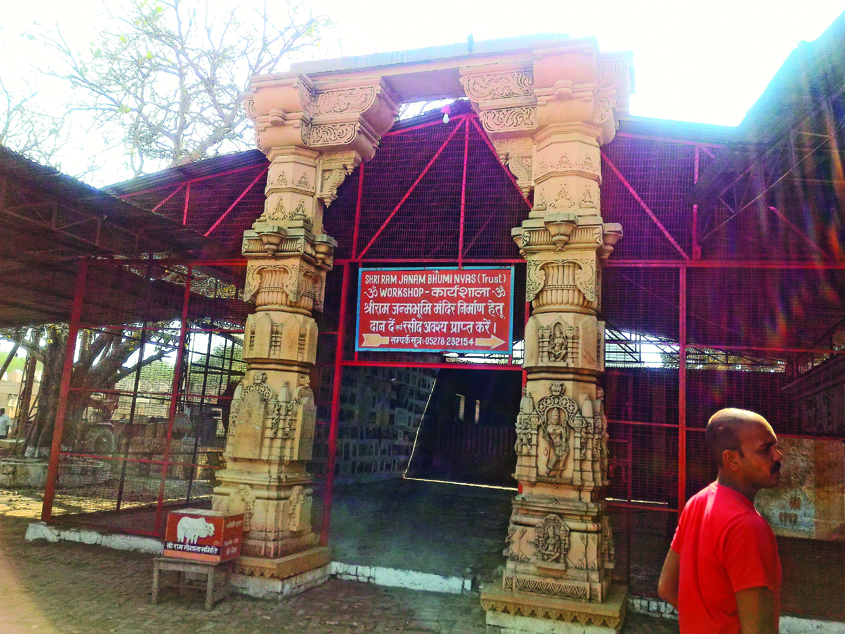“It is not a communal issue as some call it; it is a matter of faith. None of my Muslim friends are against the building of a Ram temple in Ayodhya. Many of the media reports that are written on the construction of a Ram temple in Ayodhya are written by people who have never visited the place. Do you think the construction of the Ram temple here will lead to problems here or anywhere else in the country? Did you ‘feel’ communalism in the air in Ayodhya as is reported in the media? We sincerely feel that a BJP win in Uttar Pradesh will accelerate the construction of the temple and I do not think there is anything communal about it. If a Ram temple is not built in Ayodhya, where will it be built?” asked Rajnikant, a 50-year-old mason who has been working at a “Karsevakpuram” workshop in Ramghat locality, 2.5 km from where Ram “resides”. Rajnikant, who is from Surendranagar district of Gujarat, has been working on large-sized sandstones that are brought from Bharatpur in Rajasthan for the construction of the proposed temple.
Apart from these stones, thousands and thousands of bricks that have been donated by people from across the country and from devotees as far as Southampton, United Kingdom and Netherlands for the construction of the temple are also there in the workshop.
After going through four separate levels of personal frisking, a devotee is led in front of a makeshift sanctum sanctorum that has been built of a tent, where the statue of Ram, Sita, Laxman and Bharat, are kept at a distance of 10 feet from the fence that separates the lords and devotees.
A priest who was sitting at the makeshift structure that has been erected where the Babri Masjid stood, said that the razing of the “structure” was a part of history now and the building of the temple was an inevitable thing.
“Politicians till now have treated the Ram temple as an issue that is to be raised during election time. However, now the time has come when the temple should come up. And this has to be done amicably, after taking Muslims into confidence,” the priest, who did not want to be named, said.
Apart from these stones, thousands of bricks have been donated by people from across the country and from devotees from as far as Southampton.
Sandeep Pandey, 31, a local tourist guide who is one of the many in Ayodhya who take visitors and pilgrims who come to Ayodhya on a guided tour, said that the assembling of the outer structure for the proposed temple was going on. “Right now, there are 50 plus workers and masons who are working on the construction of the temple which is being overseen by the Ram Janmabhoomi Nyas. Around 60-70% work has been completed in the past 25 years and if the number of workers and masons is increased to 500, the temple will be completed within a year,” he said.
According to him, there was a general consensus among the people of Ayodhya that the BJP, if it comes to power in the state, will make sure that the temple is built within a given time frame. “I am not communal (kattar), I do not support anti-Muslim speeches but yes I want the Ram temple to come up. I feel that the BJP can only make this happen, but that does not mean that I am supporting its candidates just on the basis of this,” he said.
Last Tuesday, when BJP national president Amit Shah was doing a “Vijay Shankhnad” road show in Allahabad , party followers continued to chant Ram lalla hum aayenge, mandir wahin banayenge all along the 6 km route, reaffirming the views that Ram Mandir was an emotive issue, if not a political one for followers of the party.
Elections in Ayodhya are scheduled to be held on 27 February (fifth phase). The sitting Samajwadi Party MLA is Tej Narayan Pandey who is contesting against Bazmi Siddiqui of BSP and Ved Prakash Gupta of the BJP who has the distinction of being with all the four mainstream parties (Congress, BJP, BSP, SP) in the past 30 years. Gupta contested the 2002 election on an SP ticket. In 2012, he contested the same seat for the BSP and came in the third position.
Though it takes only two hours to reach Ayodhya from Lucknow via the pothole free National Highway 28 and despite doing a rally in Lucknow last month, Prime Minister Narendra Modi did not visit the Ram temple nor had he visited the temple site when he had done a rally in Faizabad in 2014.
The locals say that this is because of political compulsion. “Such is the state of politics here that Modi, even if he wants to, cannot visit the site as it is seen as ‘disputed’ by some writers and journalists and if Modi comes here, he will be termed communal. However, if Modi visits the temple site and seeks Ram’s blessing, it will help both Ram and him,” the priest said.

